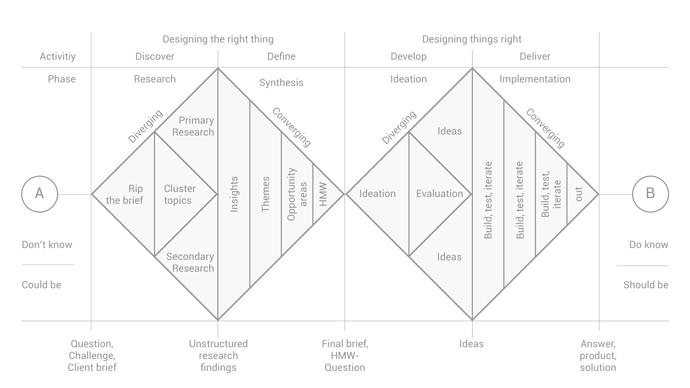Here @pjppauwels’s notes reflecting on the same meeting:
SCORE’s baseline could be Bart Rosseau’s quote: Think local, Code Global. (oppositish from Think Global, Act local, with emphasis on: Build things for your specific city (service), but think about how other can re-use that code for their benefit or usecase.
A double diamond could help think about solutions:
- Diverge (on a challenge level): Look for real world challenges amongst cities.
- Converge (on a challenge level): Translate into common challenges and translate into solutions (start of second diamond).
- Diverge (on a technical level): Based on the commons challenges translate to technological solutions and diverge back to what frameworks, open source code bases, technology stacks, open standards do already exist.
- Converge (on a technical level): Choose a mixture of what works for the cities and converge into an service platform upon which cities can build their specific final city service / usecase / solution?
Learnings for Ghent: We’re in a difficult place right now. We’re keen to start developing and in september will have a dedicated employee working with us on this project as a project manager, as well as a developer. But on the other hand it hard to get buy-in on the city side for the 5 current working groups as they are not really aligned with the common challenges we put forward back before the kick-off. We’re trying to abstract projects and see how they can serve a purpose beyond the specific solutions that are being presented in the working groups.
These were our five original ones:
-
| Mobility |
Traffic Flow |
Realtime insight |
Multi Modal |
We’re looking for a way to continuously screen on what the points of pain are regarding mobility in, measuring the impact of mobility on certain target groups, and how we could possible improve on this. |
Can this be linked back to impact of events on mobility in which we use IoT devices to measure changes in traffic patterns due certain events?
-
| Mobility |
Accessibility |
Routing |
Crowdsourcing |
People with physical disabilities still have a hard time getting by around the city, not knowing what parts are accessible with a wheel chair or other aids. |
Can the travel time tool app be used to help people with psychical disabilities to visualise how hard it is for them to get from point A to B in minutes and what actions would mitigate the time gap between citizens with disabilities and citizens without disabilities?
-
| Environment |
Green space |
Crowdsourcing |
Sensibilisation |
How can we incentivize citizens and companies to install facade plants and maximize green space where available. |
Can we use the basis of the IoT register to create a private green space register?
-
| Environment |
Urban Planning |
Sensibilisation |
How can we maximise environmental adjustments and how can we communicate about these efforts in order to incentivize other stakeholders in the city. |
-
Due to soil sealing the city is facing urban heat island challenges and cannot absorb water on a district level leading to a number of negative effects.
| Water |
Soil sealing |
Drainage |
Green space |
How can we maximise environmental adjustments and how can we communicate about these efforts in order to incentivize other stakeholders in the city. |
Can we use the drainage working group to think about not only measuring drainage issue, but translate them into urban planning where green space is also a way for water absorption?
I imagine when you would look at the working groups, not as fixed end to end solutions, but as higher level abstracted clusters of baseline services, you would be able to fit in these scopes and make sure that the same technology stack serves multiple use-cases.
And that for me the biggest challenge within SCORE. It’s not necessarily about does the solution fit with in my city, but does the technology that supports that solution is useful in my city as well?







